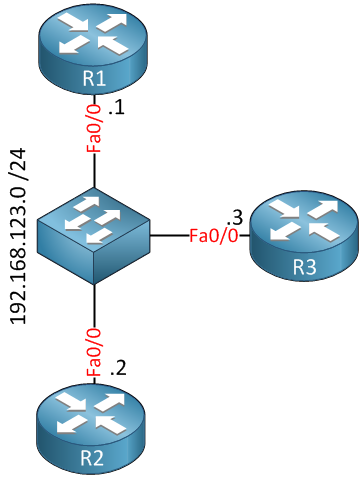RSVP will work fine when you need to make a reservation on the link between two routers, but what if you have a shared segment? An example could be a couple of routers that is connected to the same half-duplex Ethernet network. These routers will share the bandwidth so when multiple routers make an RSVP reservation it’s possible that we oversubscribe.
The routers should know about all RSVP reservations that are made on this shared segment and that’s exactly why we have the DSBM (Designated Subnetwork Bandwidth Manager).
One of the routers on the shared segment will be elected as the DSBM and all other RSVP routers will proxy their RSVP PATH and RESV messages through the DSBM. This way, we will have centralized admission control and we won’t risk oversubscribing the shared segment.
Besides being in charge of admission control, the DSBM can also distribute other information to RSVP routers, for example, the amount of non-reservable traffic that is allowed in the shared segment or the average/peak rate and burst size for non-RSVP traffic.
The election to become the RSVP DSBM uses the following rules:
- The router with the highest priority becomes the DSBM.
- If the priority is the same, the highest IP address is the tie-breaker.
Multiple DSBMs can be configured for a shared segment, but DSBM is non-preemptive. This means that once the election is over, the elected router will stay as the DSBM even if you configure another router later with a higher priority.
Configuration
Configuration-wise, it’s easy to implement DSBM. Let’s use the following topology to see how it works:

Just three routers connected to the same switch. First, we will enable RSVP on all interfaces:
R1(config)#interface FastEthernet 0/0
R1(config-if)#ip rsvp bandwidthR2(config)#interface FastEthernet 0/0
R2(config-if)#ip rsvp bandwidthR3(config)#interface FastEthernet 0/0
R3(config-if)#ip rsvp bandwidthNow we’ll configure R3 as the DSBM for this segment:
R3(config)#interface FastEthernet 0/0
R3(config-if)#ip rsvp dsbm candidateIf you want, you can configure the DSBM to tell other RSVP routers to limit the reservations:



Dear Rene,
Could you explain where practically (Scenario) this would be used?
Regards,
Rajiv R
Hello,
I would like to ask if any non-resv-send-limit was configured on R3. I can see some Non Resv Send Limit values for current DSBM outputs. Also on R3 output there is no Non Resv Send Limit displayed for Local Configuration.
One small remark is for the Configuration tab / R3 at the end of the chapter. There should be an
ip rsvp dsbm candidate.Many thanks,
Stefanita
Hi Stefanita,
I didn’t configure anything on purpose, but there are some default RSVP commands. Here are all
rsvpcommands we configured:And here are all default
... Continue reading in our forumHi,
I understood your example and config great, the only thing i didn’t quite get was the “oversubscribe” meaning and why this is the reason we need to use DSBM…
Thanks again
Hello Michael
Oversubscribing refers to the practice of designing a network, or arranging network traffic patterns, in such a way as to end up having more traffic arrive at an interface than it is able to carry. In other words, if you oversubscribe a particular network path, or interface, you are essentially creating a bottleneck.
For example, take a look at this diagram from the lesson:
https://cdn-forum.networklessons.com/uploads/default/original/2X/6/62db1aa14c061dd61e377438984bb3d00a5e35e5.png
Imagine we have traffic arriving from R3 and from R1, being rou... Continue reading in our forum